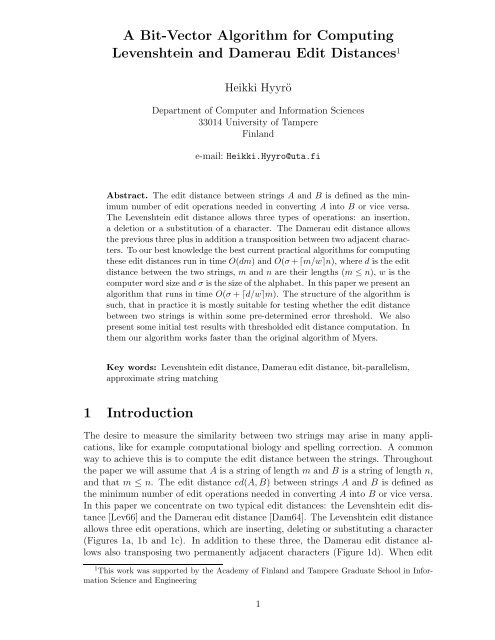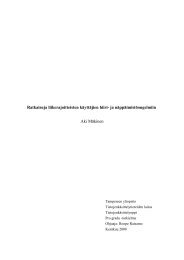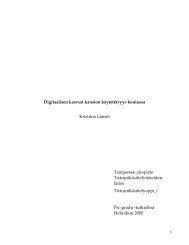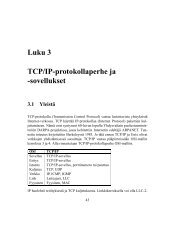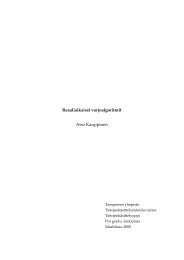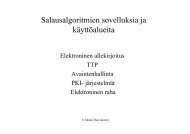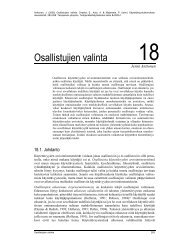A Bit-Vector Algorithm for Computing Levenshtein and ... - CiteSeerX
A Bit-Vector Algorithm for Computing Levenshtein and ... - CiteSeerX
A Bit-Vector Algorithm for Computing Levenshtein and ... - CiteSeerX
Create successful ePaper yourself
Turn your PDF publications into a flip-book with our unique Google optimized e-Paper software.
A <strong>Bit</strong>-<strong>Vector</strong> <strong>Algorithm</strong> <strong>for</strong> <strong>Computing</strong><strong>Levenshtein</strong> <strong>and</strong> Damerau Edit Distances 1Heikki HyyröDepartment of Computer <strong>and</strong> In<strong>for</strong>mation Sciences33014 University of TampereFinl<strong>and</strong>e-mail: Heikki.Hyyro@uta.fiAbstract. The edit distance between strings A <strong>and</strong> B is defined as the minimumnumber of edit operations needed in converting A into B or vice versa.The <strong>Levenshtein</strong> edit distance allows three types of operations: an insertion,a deletion or a substitution of a character. The Damerau edit distance allowsthe previous three plus in addition a transposition between two adjacent characters.To our best knowledge the best current practical algorithms <strong>for</strong> computingthese edit distances run in time O(dm) <strong>and</strong> O(σ + ⌈m/w⌉n), where d is the editdistance between the two strings, m <strong>and</strong> n are their lengths (m ≤ n), w is thecomputer word size <strong>and</strong> σ is the size of the alphabet. In this paper we present analgorithm that runs in time O(σ + ⌈d/w⌉m). The structure of the algorithm issuch, that in practice it is mostly suitable <strong>for</strong> testing whether the edit distancebetween two strings is within some pre-determined error threshold. We alsopresent some initial test results with thresholded edit distance computation. Inthem our algorithm works faster than the original algorithm of Myers.Key words: <strong>Levenshtein</strong> edit distance, Damerau edit distance, bit-parallelism,approximate string matching1 IntroductionThe desire to measure the similarity between two strings may arise in many applications,like <strong>for</strong> example computational biology <strong>and</strong> spelling correction. A commonway to achieve this is to compute the edit distance between the strings. Throughoutthe paper we will assume that A is a string of length m <strong>and</strong> B is a string of length n,<strong>and</strong> that m ≤ n. The edit distance ed(A, B) between strings A <strong>and</strong> B is defined asthe minimum number of edit operations needed in converting A into B or vice versa.In this paper we concentrate on two typical edit distances: the <strong>Levenshtein</strong> edit distance[Lev66] <strong>and</strong> the Damerau edit distance [Dam64]. The <strong>Levenshtein</strong> edit distanceallows three edit operations, which are inserting, deleting or substituting a character(Figures 1a, 1b <strong>and</strong> 1c). In addition to these three, the Damerau edit distance allowsalso transposing two permanently adjacent characters (Figure 1d). When edit1 This work was supported by the Academy of Finl<strong>and</strong> <strong>and</strong> Tampere Graduate School in In<strong>for</strong>mationScience <strong>and</strong> Engineering1
Paper Submitted <strong>for</strong> PSCdistance is used, strings A <strong>and</strong> B are deemed similar iff their edit distance is smallenough, that is iff ed(A, B) ≤ k, where k is some pre-determined error threshold. Arelated problem is that of approximate string matching, which is typically defined asfollows: let pat be a string of length m <strong>and</strong> text a (much longer) string of length n.The task of approximate string matching is then to find all such indices j, <strong>for</strong> whichexists such h ≥ 0 that ed(pat, text[j − h..j]) ≤ k.The oldest, but most flexible in terms of permitting different edit operations<strong>and</strong>/or edit operation costs, algorithms <strong>for</strong> computing edit distance (<strong>for</strong> example[WF74]) are based on dynamic programming <strong>and</strong> run in time O(mn). Ukkonen[Ukk85a] has later proposed two O(dm) methods, <strong>and</strong> Myers [Mye86] an O(n + d 2 )method. The latter is based on using a suffix tree <strong>and</strong> is not viewed as being practical(e.g. [Ste94]). With fairly little modifications these methods can also be used incomputing the Damerau edit distance without affecting the asymptotic run times.The methodology of using so-called ”bit-parallelism” in developing fast <strong>and</strong> practicalalgorithms has recently become popular in the field of string matching. Wu <strong>and</strong>Manber [WM92] presented an O(d⌈m/w⌉n) bit-parallel algorithm <strong>for</strong> <strong>Levenshtein</strong> editdistance -based approximate string matching, <strong>and</strong> in [Nav01] it was modified to computeboth <strong>Levenshtein</strong> <strong>and</strong> Damerau edit distance. The run time remained the same.Then Baeza-Yates <strong>and</strong> Navarro presented a method, which enables an O(⌈dm/w⌉n)algorithm <strong>for</strong> the <strong>Levenshtein</strong> edit distance. Currently this algorithm has not beenextended <strong>for</strong> the Damerau edit distance. Finally Myers [Mye99] has presented anO(⌈m/w⌉n) algorithm <strong>for</strong> approximate string matching under the <strong>Levenshtein</strong> editdistance. In [Hyy01] the algorithm was extended <strong>for</strong> computing the Damerau editdistance.In this paper we will present an initial study on combining one of the O(dm)edit distance algorithms of Ukkonen [Ukk85a] with the bit-parallel algorithm of Myers[Mye99] to obtain a faster algorithm. We begin by reviewing these underlyingalgorithms in the next section.2 PreliminariesIn the following discussion let A be a string of length m <strong>and</strong> B a string of lengthn. We also use the notation A[u] to denote the uth character of A <strong>and</strong> the notationA[u..v] to denote the substring of A, which begins from its uth character <strong>and</strong> endsat its vth character. The superscript R denotes the reverse string: <strong>for</strong> example if A= ”ABC”, then A R = ”CBA”. For bit operations we use the following notation: ’&’denotes bitwise“<strong>and</strong>”, ’|’ denotes bitwise “or”, ’∧’ denotes bitwise “xor”, ’∼’ denotesbit complementation, <strong>and</strong> ’’ denote shifting the bit-vector left <strong>and</strong> right,respectively, using zero filling in both directions. We refer to the ith bit of the bitvector V as V [i]. <strong>Bit</strong>-positions are assumed to grow from right to left, <strong>and</strong> we usesuperscript to denote bit-repetition. As en example let V = 1001110 be a bit vector.Then V [1] = V [5] = V [6] = 0, V [2] = V [3] = V [4] = V [7] = 1, <strong>and</strong> we could alsowrite V = 10 2 1 3 0.2
Paper Submitted <strong>for</strong> PSCT C T T G A A G G T C A0 1 2 3 4 5 6 7 8 9 10 11 12A 1T 2C 3A 4G 5C 6C 7T 8Figure 2: An example of the column-wise filling order <strong>for</strong> the dynamic programmingtable of strings ”ATCAGCCT” <strong>and</strong> ”TCTTGAAGGTCA”.Even though these rules were initially presented with the <strong>Levenshtein</strong> edit distance,they can easily be seen to apply also with the Damerau edit disance.2.2 Using bit-parallelismMyers [Mye99] presented an O(⌈m/w⌉n) algorithm <strong>for</strong> approximate string matchingunder the <strong>Levenshtein</strong> edit distance. Later in [Hyy01] the algorithm was slightly modified<strong>and</strong> extended <strong>for</strong> the Damerau edit distance. Originally these algorithms weredesigned <strong>for</strong> approximate string matching, but they can easily be modified to computeedit distance. The algorithms process the jth column of the dynamic programmingmatrix in O(⌈m/w⌉) time by using bit-parallelism. This is done by using delta encodingin the matrix: instead of explicitly computing the values D[i, j] <strong>for</strong> i = 1..m<strong>and</strong> j = 1..n, the following length-m binary valued delta vectors are computed <strong>for</strong>j = 1..n:-The vertical positive delta vector V P j : V P j [i] = 1 iff D[i, j] − D[i − 1, j] = 1.-The vertical negative delta vector V N j : V N j [i] = 1 iff D[i, j] − D[i − 1, j] = −1.-The horizontal positive delta vector HP j : HP j [i] = 1 iff D[i, j] − D[i, j − 1] = 1.-The horizontal negative delta vector HN j : HN j [i] = 1 iff D[i, j] − D[i, j − 1] = −1.-The diagonal zero delta vector D0 j : D0 j [i] = 1 iff D[i, j] = D[i − 1, j − 1].When the values <strong>for</strong> these delta vectors are known <strong>for</strong> the (j − 1)th column, theycan be computed <strong>for</strong> the jth column in an efficient manner when the following matchvector is available <strong>for</strong> each character λ.-The match vector PM λ : PM λ [i] = 1 iff A[i] = λ.For simplicity we use the notation PM j = PM B[j] <strong>for</strong> the rest of the paper. It isstraight<strong>for</strong>ward to compute the pattern match vectors in O(σ + m) time. In thefollowing we assume that these vectors have already been computed <strong>and</strong> are readilyavailable.The delta vectors enable the value ed(A, B[1..j]) to be explicitly calculated <strong>for</strong>j = 1, 2, . . .,n: ed(A, B[1..j]) = ed(A, B[1..j −1])+1 iff HP j [m] = 1, ed(A, B[1..j]) =ed(A, B[1..j−1])−1 iff HN j [m] = 1, <strong>and</strong> ed(A, B[1..j]) = ed(A, B[1..j−1]) otherwise.Thus after all n columns are processed, the value ed(A, B[1..n]) = ed(A, B) is known.4
A <strong>Bit</strong>-<strong>Vector</strong> <strong>Algorithm</strong> <strong>for</strong> <strong>Computing</strong> <strong>Levenshtein</strong> <strong>and</strong> Damerau Edit DistancesFigures 3 <strong>and</strong> 4 show the algorithms based on [Hyy01] <strong>for</strong> computing the jth columnwhen m ≤ w, that is, when each vector can be represented by a single bit-vector.Both algorithms are modified to compute edit distance. The algorithm in Figure 3 is<strong>for</strong> the <strong>Levenshtein</strong> edit distance, <strong>and</strong> the algorithm in Figure 4 is <strong>for</strong> the Damerauedit distance. Both algorithms involve a constant number of operations, <strong>and</strong> thuscompute the delta vectors <strong>for</strong> the jth column in O(1) time. In this paper we do notseparately discuss the case m > w. As each required operation <strong>for</strong> a length-m bitvector can be simulated in O(⌈m/w⌉) time using ⌈m/w⌉ length-w bit vectors, thegeneral runtime of the algorithms is O(⌈m/w⌉) <strong>for</strong> each column. This results in atotal time of O(⌈m/w⌉n) over all n columns in computing ed(A, B).<strong>Computing</strong> the jth column (<strong>Levenshtein</strong> distance)1. D0 j ← (((PM j & V P j−1 ) + V P j−1 ) ∧ V P j−1 ) | PM j | V N j−12. HP j ← V N j−1 | ∼ (D0 j | V P j−1 )3. HN j ← D0 j & V P j−14. If HP j & 10 m−1 ≠ 0 Then D[m,j] ← D[m,j] + 15. If HN j & 10 m−1 ≠ 0 Then D[m,j] ← D[m,j] − 16. V P j ← (HN j
Paper Submitted <strong>for</strong> PSCconsists of the cells D[i, j] <strong>for</strong> which j − i = q. From the diagonal <strong>and</strong> adjacencyproperties Ukkonen concluded that if ed(A, B) ≤ t <strong>and</strong> m ≤ n, then it is sufficient tofill only the cells in the diagonals −⌊(t − n + m)/2⌋, −⌊(t − n + m)/2⌋ + 1, . . .,⌊(t +n − m)/2⌋ of the dynamic programming matrix. All the other cell values can beassumed to have an infinite value without affecting correct computation of the valueD[m, n] = ed(A, B). He used this rule by beginning with t = (n − m) + 1 <strong>and</strong> fillingthe above-mentioned diagonal interval of the dynamic programming matrix. If theresult is D[m, n] > t, t is doubled. Eventually D[m, n] ≤ t, <strong>and</strong> in this case it isknown that D[m, n] = ed(A, B). The run time of this procedure is dominated by thecomputation involving the last value of t. As this value is < 2 × ed(A, B) <strong>and</strong> witheach value of t the computation takes O(t × min(m, n)) time, the overall run time isO(ed(A, B) × min(m, n)).In addition Ukkonen proposed a dynamic ”cutoff” method to improve the practicalper<strong>for</strong>mance of the diagonal restriction method. Assume that column-wise order isused in filling the cells D[i, j] inside the required diagonals −⌊(t − n + m)/2⌋, −⌊(t −n + m)/2⌋ + 1, . . .,⌊(t + n − m)/2⌋. Let r u hold the diagonal number of the upmost<strong>and</strong> r l the diagonal number of the lowest cell that was deemed to have to be filled inthe jth column. Then due to the diagonal property we can try to shrink the diagonalregion by decrementing r u as long as D[r u , j] > t <strong>and</strong> incrementing r l as long asD[r l , j] > t. Then at the (j +1)th column it is enough to fill the cells in the diagonalsr l . . .r u . If r l > r u the diagonal region vanishes <strong>and</strong> it is known that ed(A, B) > t.This method of ”guessing” a starting limit t <strong>for</strong> the edit distance <strong>and</strong> then doublingit if necessary is not really practical <strong>for</strong> actual edit distance computation. Eventhough the asymptotic run time is good, it involves large constant factor whenevered(A, B) is large. But the method works well in practice in thresholded edit distancecomputation, as then one can immediately set t = k <strong>and</strong> only a single pass is needed.3 Our MethodIn this section we present a bit-parallel version of the diagonal restriction scheme ofUkkonen, which was briefly discussed in Section 2. In the following we concentrateon the case where the computer word size w is large enough to cover the requireddiagonal region. Let l v denote the length of the delta vectors. Then our assumptionmeans that w ≥ l v = min(m, ⌊(t − n + m)/2⌋ + ⌊(t + n − m)/2⌋ + 1). Note that inthis case each of the pattern match vectors PM λ may have to be encoded with morethan one bit vector: If m > w, then PM λ consists of ⌈m/w⌉ bit vectors.3.1 Diagonal tilingThe basic idea is to mimic the diagonal restriction method of Ukkonen by tiling thevertical delta vectors diagonally instead of horizontally (Figure 5a). We achieve thisby modifying slightly the way the vertical delta vectors V P j <strong>and</strong> V N j are used: Be<strong>for</strong>eprocessing the jth column the vertical vectors V P j−1 <strong>and</strong> V N j−1 are shifted one stepup (to the right in terms of the bit vector) (Figure 5b). When the vertical vectors areshifted up, their new lowest bit-values V P j [l v ] <strong>and</strong> V N j [l v ] are not explicitly known.This turns out not to be a problem. From the diagonal <strong>and</strong> adjacency properties wecan see that the only situation which could be troublesome is if we would incorrectly6
A <strong>Bit</strong>-<strong>Vector</strong> <strong>Algorithm</strong> <strong>for</strong> <strong>Computing</strong> <strong>Levenshtein</strong> <strong>and</strong> Damerau Edit Distancesj -1 j j -1 j j -1 ja) b) c)Figure 5: a) Horizontal tiling (left) <strong>and</strong> diagonal tiling (right). b) The figure showshow the diagonal step aligns the (j − 1)th column vector one step above the jthcolumn vector. c) The figure depicts in gray the region of diagonals, which are filledaccording to Ukkonen’s rule. The cells on the lower boundary are in darker tone.have a value V N j [l v ] = 1. This is impossible, because it can happen only if D0 j hasan ”extra” set bit at position l v +1 <strong>and</strong> HP j [l v ] = 1, <strong>and</strong> these two conditions cannotsimultaneously be true.In addition to the obvious way of first computing V P j <strong>and</strong> V N j in normal fashion<strong>and</strong> then shifting them up (to the right) when processing the (j + 1)th column, wepropose also a second option. It can be seen that essentially the same shifting effectcan be achieved already when the vectors V P j <strong>and</strong> V N j are computed by making thefollowing changes on the last two lines of the algorithms in Figures 3 <strong>and</strong> 4:-The diagonal zero delta vector D0 j is shifted one step to the right on the secondlast line.-The left shifts of the horizontal delta vectors are removed.-The OR-operation of V P j with 1 is removed.This second alternative uses less bit operations, but the choice between the two maydepend on other practical issues. For example if several bit vectors have to be usedin encoding D0 j , the column-wise top-to-bottom order may make it more difficult toshift D0 j up than shifting both V P j <strong>and</strong> V N j down.We also modify the way some cell values are explicitly maintained. We chooseto calculate the values along the lower boundary of the filled area of the dynamicprogramming matrix (Figure 5c). For two diagonally consecutive cells D[i − 1, j − 1]<strong>and</strong> D[i, j] along the diagonal part of the boundary this means setting D[i, j] =D[i−1, j −1] if D0 j [l v ] = 1, <strong>and</strong> D[i, j] = D[i−1, j −1]+1 otherwise. The horizontalpart of the boundary is h<strong>and</strong>led in similar fashion as in the original algorithm of Myers:For horizontally consecutive cells D[i, j − 1] <strong>and</strong> D[i, j] along the horizontal part ofthe boundary we set D[i, j] = D[i, j − 1] + 1 if HP j [l v ] = 1, D[i, j] = D[i, j − 1] − 1if HN j [l v ] = 1, <strong>and</strong> D[i, j] = D[i, j − 1] otherwise. Here we assume that the vectorlength l v is appropriately decremented as the diagonally shifted vectors would startto protrude below the lower boundary.Another necessary modification is in the way the pattern match vector PM j isused. Since we are gradually moving the delta vectors down, the match vector has tobe aligned correctly. This is easily achieved in O(1) time by shifting <strong>and</strong> OR-ing thecorresponding at most two match vectors.The last necessary modifications concern the first line of the algorithm <strong>for</strong> theDamerau edit distance in Figure 4. First of all the diagonal delta vector D0 j isshifted down (left), which is not necessary when the vectors are tiled diagonally.7
Paper Submitted <strong>for</strong> PSCBecause of similar reason the vector PM j−1 has to be shifted one step up (to theright). This means that also the value PM j−1 [l v + 1] will have to be present in thematch vector PM j−1 . We do not deal with this separately, but assume <strong>for</strong> now onthat l v +1 ≤ w when dealing with the Damerau edit distance. Another option wouldbe to set the last bit separately, which can be done in O(1) time.Figures 6 <strong>and</strong> 7 show the algorithms <strong>for</strong> computing the vectors at the jth columnwhen diagonal tiling is used. We do not show separate versions <strong>for</strong> the different casesof updating the cell value at the lower boundary. It is done using one of the previouslymentioned ways of using D0 j (diagonal stage) or HP j <strong>and</strong> HN j (horizontal stage).When l v ≤ w, each column of the dynamic programming matrix is computed inO(1) time, which results in the total time being O(σ + n) including also time <strong>for</strong>preprocessing the pattern match vectors. In the general case, in which l v > w, eachlength-l v vector can be simulated by using ⌈l v /w⌉ length-w vectors. This can be donein O(⌈l v /w⌉) time per operation, <strong>and</strong> there<strong>for</strong>e the algorithm has in general a runtime O(σ + ⌈l v /w⌉n), which is O(σ + ⌈ed(A, B)/w⌉ × n) as l v = O(ed(A, B)). Theslightly more favourable time complexity of O(σ + ⌈ed(A, B)/w⌉ × m) in the generalcase can be achieved by simply reversing the roles of the strings A <strong>and</strong> B: We stillhave that l v = O(ed(A, B)), but now there is m columns instead of n. In this casethe cost of preprocessing the match vectors is O(σ + n), but the above complexitieshold since n = O(ed(A, B) × m) when n > m.<strong>Computing</strong> the jth column in diagonal tiling (<strong>Levenshtein</strong> distance)1. Build the correct match vector into PM j2. D0 j ← (((PM j & V P j−1 ) + V P j−1 ) ∧ V P j−1 ) | PM j | V N j−13. HP j ← V N j−1 | ∼ (D0 j | V P j−1 )4. HN j ← D0 j & V P j−15. Update the appropriate cell value at the lower boundary.6. V P j ← HN j | ∼ ((D0 j >> 1) | HP j )7. V N j ← (D0 j >> 1) & HP jFigure 6: Computation of the jth column with the <strong>Levenshtein</strong> edit distance <strong>and</strong>diagonal tiling (<strong>for</strong> the case l v ≤ w).4 Test ResultsIn this section we present initial test results <strong>for</strong> our algorithm in the case of computingthe <strong>Levenshtein</strong> edit distance. We concentrate only on the case where one wants tocheck whether the edit distance between two strings A <strong>and</strong> B is below some predeterminederror-threshold k. This is because the principle of the algorithm makes itin practice most suitable <strong>for</strong> this type of use. There<strong>for</strong>e all tested algorithms used ascheme similar to the cutoff method briefly discussed in the end of Section 2.3. As abaseline we also show the runtime of using the O(⌈m/w⌉n) bit-parallel algorithm ofMyers.8
A <strong>Bit</strong>-<strong>Vector</strong> <strong>Algorithm</strong> <strong>for</strong> <strong>Computing</strong> <strong>Levenshtein</strong> <strong>and</strong> Damerau Edit Distances<strong>Computing</strong> the jth column in diagonal tiling (Damerau distance)1. Build the correct match vector into PM j2. D0 j ← (∼ D0 j−1 ) & (PM j > 1)3. D0 j ← D0 j | (((PM j & V P j−1 ) + V P j−1 ) ∧ V P j−1 ) | PM j | V N j−14. HP j ← V N j−1 | ∼ (D0 j | V P j−1 )5. HN j ← D0 j & V P j−16. Update the appropriate cell value at the lower boundary.7. V P j ← HN j | ∼ ((D0 j >> 1) | HP j )8. V N j ← (D0 j >> 1) & HP jFigure 7: Computation of the jth column with the Damerau edit distance <strong>and</strong> diagonaltiling (<strong>for</strong> the case l v ≤ w).The test consisted of repeatedly selecting two substrings in pseudo-r<strong>and</strong>om fashionfrom the DNA-sequence of the baker’s yeast, <strong>and</strong> then testing whether their <strong>Levenshtein</strong>edit distance is at most k. The computer used in the tests was a 600MhzPentium 3 with 256MB RAM <strong>and</strong> running Microsoft Windows 2000. The code wasprogrammed in C <strong>and</strong> compiled with Microsoft Visual C++ 6.0 with full optimization.The tested algorithms were:MYERS: The algorithm of Myers [Mye99] (Section 2.2) modified to compute editdistance. The run time of the algorithm does not depend on the number oferrors allowed. The underlying implementation is from the original author.MYERS(cutoff): The algorithm of Myers using cutoff modified to compute editdistance. The underlying implementation (including the cutoff-mechanism) isfrom the original author.UKKA(cutoff): The method of Ukkonen based on filling only a restricted regionof diagonals in the dynamic programming matrix <strong>and</strong> using the cutoff method(Section 2.3).UKKB(cutoff): . The method of Ukkonen [Ukk85a] based on computing the valuesin the dynamic programming matrix in increasing order. That is, the methodfirst fills in the cells that get a value 0, then the cells that get a value 1, <strong>and</strong> soon until the cell D[m, n] gets a value.OURS(cutoff): Our method of combining the diagonal restriction scheme of Ukkonenwith the bit-parallel algorithm of Myers (Section 3). We implemented asimilar cutoff method as was used by Hyyrö <strong>and</strong> Navarro with edit distancecomputation in their version of the ABNDM algorithm [HN02].The results ase shown in Figure 8. We tested sequence pairs with lengths 100,1000 <strong>and</strong> 10000, <strong>and</strong> error thresholds of 10%, 20% <strong>and</strong> 50% of the sequence length(<strong>for</strong> example k = 100, 200 <strong>and</strong> 500 <strong>for</strong> the sequence length m = n = 1000). It canbe seen that in the case of k = 10 <strong>and</strong> m = 100 UKKB(cutoff) is the fastest, but in9
Paper Submitted <strong>for</strong> PSCall other tested cases our method becomes the fastest, being 8%-38% faster than theoriginal cutoff method of Myers that is modified to compute edit distance. The goodper<strong>for</strong>mance of UKKB(cutoff) with a low value of k is not surprising as its expectedrun time has been shown to be O(m + k 2 ). [Mye86].m = n = 100 m = n = 1000 m = n = 10000error limit (%) 10 20 50 10 20 50 10 20 50UKKA(cutoff) 1,92 5,93 32,6 13,5 52,7 322 13,1 54,9 351UKKB(cutoff) 1,23 3,02 14,9 6,17 22,9 139 5,57 22,4 146MYERS(cutoff) 2,46 3,23 4,07 2,47 4,48 15,9 0,71 2,35 13,4OURS(cutoff) 2,27 2,47 3,32 1,96 3,08 10,5 0,48 1,47 9,03MYERS 4,24 17,0 14,5Figure 8: The results (in seconds) <strong>for</strong> thresholded edit distance computation betweenpairs of r<strong>and</strong>omly chosen DNA-sequences from the genome of the baker’s yeast. Theerror threshold is shown as the percentage of the pattern length (tested pattern pairshad equal length). The number of processed sequence pairs was 100000 <strong>for</strong> m = n =100, 10000 <strong>for</strong> m = n = 1000, <strong>and</strong> 100 <strong>for</strong> m = n = 10000.Conclusions <strong>and</strong> further considerationsIn this paper we discussed how bit-parallelism <strong>and</strong> a diagonal restriction schemecan be combined to achieve an algorithm <strong>for</strong> computing edit distance, which has anasymptotic run time of O(σ + ⌈d/w⌉m). In practice the algorithm is mostly suitable<strong>for</strong> checking whether ed(A, B) ≤ k, where k is a pre-determined error threshold.In this task the initial tests showed our algorithm to be competitive against othertested algorithms [Ukk85a, Mye99], which have run times O(dm) <strong>and</strong> O(σ + mn/w),respectively.During the preparation of this article we noticed that there seems to be a lack ofcomprehensive experimental comparison of the relative per<strong>for</strong>mance between differentalgorithms <strong>for</strong> computing edit distance. Thus we are planning to fill this gap in thenear future by composing a fairly comprehensive survey on algorithms <strong>for</strong> computingedit distance. The survey will also include a more comprehensive test with ouralgorithm.We would also like to point out that the algorithm pseudocodes we have shownhave not been optimized to remain more clear. Practical implementations could <strong>for</strong>example avoid shifting the same variable twice <strong>and</strong> maintain only the needed deltavector values in the memory (the delta vectors in the jth column are only neededwhen processing the (j + 1)th column).References[Dam64] F. Damerau. A technique <strong>for</strong> computer detection <strong>and</strong> correction of spellingerrors. Comm. of the ACM, 7(3):171–176, 1964.10


